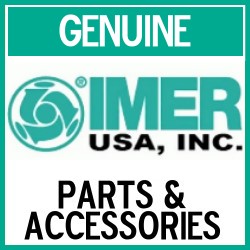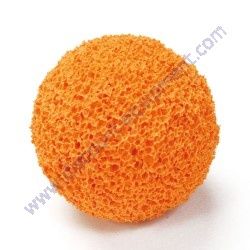IMER Mix 360 (Mortarman) 1194578 Vertical Shaft Mortar Mixer, Towable, 12CF w/ 11hp Honda Gas motor
Safety Information
IMER Mix 360 12 CF Vertical Shaft Mixer
WORKING IN SAFETY
In order to be able to work in complete safety, the following instructions must be read carefully
- This OPERATING AND MAINTENANCE manual must be kept on site
by the person responsible for the site, e.g. the SITE FOREMAN, and
must always be available for consultation.
- The manual should be considered as being an integral part of the machine, and must be kept for future reference (EN 292/2) until the machine itself is disposed of. If the manual becomes damaged or lost, a replacement can be obtained from the manufacturer.
- The manual contains important information regarding the preparation
of the site, installation and use of the machine, maintenance and spare
parts ordering. Nevertheless, the installer and operator must both have
adequate experience and knowledge of the machine.
- In order that the safety of the operator, safe working and long life of
the equipment can all be guaranteed, the instructions in this manual
must be followed together with safety standards and health and safety
at work laws currently in force (use of suitable footwear and clothing,
use of helmets, gloves and goggles, etc. in accordance with S.I N° 3073
of 30/11/92.
. ALWAYS MAKE SURE THAT SIGNS ARE LEGIBLE
. It is strictly forbidden to carry out any form of modification to
the structure or working parts of the machine.
IMER International decline any responsibility in the case of non-compliance with laws and standards governing the use of this equipment. In
particular: improper use, defective power supply, lack of maintenance,
unauthorized modifications, partial or total failure to observe instructions
contained in this manual.
3. MIXING CAPACITY
The mixing capacity of the machine per cycle is 200 liters (approximately half of the tank height).
4. SAFETY MEASURES
-The IMER cement mixer can only function if all the safety devices with
which it is equipped are in perfect condition.
-The machine will not operate if the mains connection is defective.
-On-site power connection lines must be installed so that they cannot
be damaged. Do not stand the machine on the mains connection line.
-The power lines must be installed so that water cannot penetrate connections. Only use connectors fitted with protection against water spray.
-Repairs to the electrical plant must only be carried out by specialized
personnel. Do not operate the mixer during maintenance or repair operations.
-Accident prevention and health and safety at work regulations must be
complied with in the working area.
. The machine must only be stopped using the appropriate
switch.
. Do not open the tank protection cover to stop the machine.
5. ELECTRICAL SAFETY
The IMER mixer complies with standards EN60204-1. In particular, it is
equipped with a system that prevents automatic restart after the power
supply line is interrupted.
-Residual current protection of electrical equipment
-Electrical safety device that prevents the machine from operating when
the tank protection cover is open.
When used on construction sites, the mixer can be connected to an
earthing system by attaching an earthing braid (or wire) of minimum
section 16 mm²
6. MECHANICAL SAFETY
-A guard over the outlet prevents access to the mixing zone.
-The tank protection cover allows the mix components to be loaded without access to the mixing zone.
The mixer will stop if the cover is opened.
7. TRANSPORT
WARNING!!
Always disconnect the machine from the mains before moving it.
-When on-site, the mixer can be moved manually from one location to
another
-For other types of handling, the mixer must be lifted using a four-cable
sling attached to the lifting lugs, as shown in .
8. INSTALLATION
Lift the mixer (the mixer is fitted with a lifting jack .
- Screw in the outlet opening handle.
If there are no lifting means available, lift the mixer using the jack supplied.
1 - Raise the rear supporting legs to their maximum height and lock them in position using the locking pins.
2 - Use the handle to raise the machine, resting it on the rear legs.
3 - Position the front legs (towing side) at the height required and lock them using the locking pins.
4 - If the machine is to be positioned at maximum height, insert the lower
lug in the support, raise and lock the rear legs at the third hole from the bottom.
5 - Remove the lower fork connection Ref. 5 and lower the jack so that
the upper fork connection can be inserted, then complete the lifting operation.
For intermediate working levels, the rear part of the machine should be
lifted in a single operation, as in points 1 and 2, by using the lower connection point on the jack.
To return the machine to the towing position, follow this procedure in
reverse order.
Position the machine on level ground, adjusting the telescopic legs to
the required height.
Ensure that the machine is in a stable working position.
9. USE
-Do not allow other people to remain in the vicinity of the machine during operation.
-Do not use the machine in a fire-risk zone. Sparks may cause fires or
explosions.
-Always switch off the machine before leaving it unattended.
-The machine must only be transported or positioned with the motor
switched off.
13. RESIDUAL RISKS AND SAFETY NOTICES
Although the machine is constructed in line with established legislation,
certain residual risks cannot be eliminated and require the use of indivi
dual safety equipment. The machine is equipped with notices to indicate
the residual risks and how to avoid them.
NOISE HAZARD
Wear ear defenders
HAND CRUSHING/SHEARING HAZARD
Wear gloves
EYE INJURY HAZARD
Wear safety glasses
INCORRECT USE HAZARD
Read the manual before operating the machine
TRAPPING/CRUSHING AND SHEARING HAZARD
Do not remove the guards
Do not touch drive components
ELECTROCUTION HAZARD
Danger - electrical power
Note that the employer is responsible for ensuring his workers use individual safety equipment.
DANGER INHALATION POWDER
ALWAYS avoid inhalation of and skin contact with silica dust and/or mist. Provide proper dust removal. Use dust-collection system when applicable.
CAUTION
Keep the hands away from the outlet.
SILICA DUST WARNING
Grinding/cutting/drilling of masonry, concrete, metal and other materials
with silica in their composition my give off dust or mists containing crystalline silica. Silica is a basic component of sand, quartz, brick clay, granite
and numerous other minerals and rocks. Repeated and/or substantial
inhalation of airborne crystalline silica can cause serious or fatal respiratory diseases, including silicosis. In addition, California and some other
authorities have listed respirable crystalline silica as a substance known
to cause cancer. When cutting such materials, always follow respiratory
precautions.
Use appropriate NIOSH-approved respiratory protection where dust
hazard may occur. Paper masks or surgical masks without a NIOSH
approval number are not recommended because they do little to protect
the worker. For more information about respirator programs, including
what respirators have received NIOSH approval as safe and effective,
please visit the NIOSH website at: http://www.cdc.gov/niosh/topics/respirators
Observe OSHA regulations for respirator use (29 C:F.R. § 1910.134).
Visit http://www.osha.gov for more information.
California proposition 65 message
Some dust created by power sanding, sawing, grinding, drilling, and other
construction activities contain chemicals know (to the State of California)
to cause cancer, birth defects or other reproductive harm. Some examples of these chemicals are:
-Lead, from lead-based paints
-Crystalline silica, from bricks and cement and other masonry products
-Arsenic and chromium, from chemically treated lumber
For further information , consult the following sources:
http://www.osha.gov/dsg/topics/silicacrystalline/index.html
http://www.cdc.gov/niosh/docs/96-112/
http://oehha.ca.gov/prop65/law/P65law72003.html
http://www.dir.ca.gov/Title8/sub4.html
http://www.P65warnings.ca.gov
Your risk from these exposures varies depending on how often you do
this type of work. To reduce your exposure to these chemicals, work in a
well-ventilated area, and work with approved safety equipment, such as
dust masks that are specially designed to filter out microscopic particles.
Where use of a dust extraction device is possible, it should be used. To
achieve a high level of dust collection, use an industrial HEPA vacuum
cleaner. Observe OSHA 29 CFR part 1926.57 and 1926.103. |













